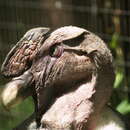Biology
provided by Arkive
Andean condors roost on cliff faces and use thermal currents to lift off in the morning, and then spend most of the day soaring on updrafts looking for food. These birds scavenge on the remains of sheep, llama, cattle, seals and occasionally newborn animals or the eggs of sea birds. Their excellent eyesight allows them to spot a carcass from several miles away, and these birds are also known to watch the behaviour of other animals or follow smaller scavenger birds to find a carcass (7). Their sharp, curved beaks can easily tear through the flesh and hides of the toughest carcasses (7) (9). Up to 40 birds have been observed together at a single large carcass (2).
The Andean condor has a long life, in excess of 50 years, but breeds very slowly (7). Sexual maturity is not attained until seven to eleven years, after which these birds, like all condors, mate for life (7). The male conducts an elaborate courtship display involving drawing the body up and fully extending the wings, as well as making loud tongue clicks, while the reddish skin of the neck becomes bright yellow (8). The female lays a single egg every other year, which both birds take turns to incubate (7) for about 54 to 58 days (8). The young take a lot of time and effort to raise, being unable to fly until they are six months old and reliant upon their parents for up to two more years (2) (7).
Conservation
provided by Arkive
Recovery attempts have been made through captive breeding and reintroduction programmes, which have been moderately successful (7). Captive-bred Andean condors have so far been reintroduced into the wild in Colombia and Venezuela, and early reports indicate that that some of these birds have begun to breed (8). These results are extremely encouraging and provide hope for the successful preservation of this magnificent bird. A similar project is currently underway in Argentina, and there is potential for reintroductions to be made throughout the species' former range (10). However, it is imperative that an education campaign to try to reduce hunting of this bird accompanies such measures, if reintroduced individuals are to be given the best possible chance of survival.
Description
provided by Arkive
As one of the largest flying birds in the world, the Andean condor forms an awesome sight over the South American skies (5), as it soars gracefully on huge, motionless wings (6). These magnificent birds have a glossy black plumage with white flight feathers on the wing (7) and a distinctive downy, white ruff around the neck (8). The bare skin on the head varies in colour, but is usually reddish-pink at the base of the neck, and more mottled greyish-pink or yellow on the head (2). These birds have large feet with powerful claws and sharp, hooked beaks that allow them to easily tear apart their scavenged prey (9). This condor is the only American vulture to show sexual dimorphism, with males possessing a large, fleshy lump on the front of their heads, called a caruncle, and neck wattles that are absent in females (2) (9). Juveniles are a dull brown colour (2).
Habitat
provided by Arkive
Found in high mountains, lowland deserts, open grasslands, along coastlines and in alpine regions (9). Unlike many birds, the Andean condor doesn't build nests, but rather lays its eggs among boulders or in caves or holes (9).
Range
provided by Arkive
Ranging across the Andes, in Venezuela, Colombia, Ecuador, Peru, Bolivia, Paraguay south to Argentina and Chile (10).
Status
provided by Arkive
Classified as Near Threatened (NT) on the IUCN Red List (1), listed on Appendix I of CITES (3) and listed on Appendix II of the Convention on Migratory Species (CMS) (4).
Threats
provided by Arkive
The Andean condor is adapted for exceptionally low mortality and low reproductive output, and is therefore highly vulnerable to human persecution, which persists over most of its range (2) (10). The condor is killed for sport and farmers kill them as pests because they mistakenly believe they kill their livestock (7) (9). Additionally, condors have suffered from pesticides that have been carried up the food chain (7) (9) and from poison placed for mammalian predators (8). As this bird mates for life, and shares parental duties, the death of a mate also has a knock-on impact on the other partner and their chick (7).

